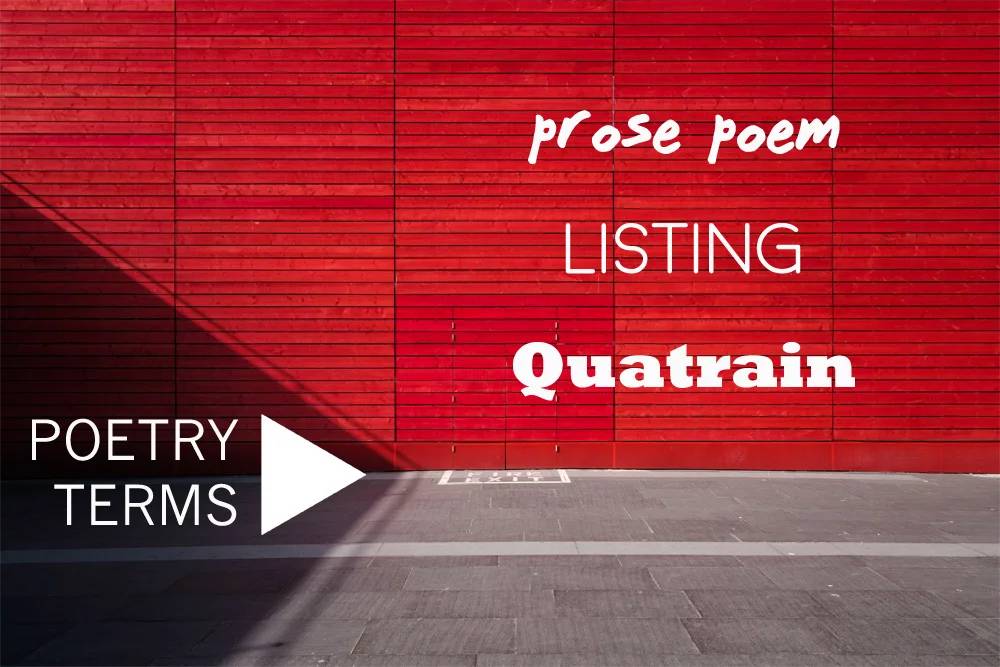Poetry Terms: Prose Poem, Listing, & Quatrain

Our Poetry Terms series takes a closer look at the words we use when we talk about poetry. These three terms, Prose Poem, Listing, & Quatrain, represent three different architectures of our poems, and while their definitions may be mild on the surface, the greatest poets are intimate with every nook and cranny. Each demands of us careful consideration every time we sit and pin one word to another.
Prose Poems
The divide between poetry and prose is perhaps now more fluid than ever. The French poet and Poe-admirer, Charles Baudelaire arguably first popularized the prose poem with his book Petits Poemes en Prose in 1869.
Many poets define poetry by its focus on the measured line, so the contention that prose poems bring up is unsurprising. These are poems that often toe the line toward short story and flash fiction. They’ll have dialogue, plot, characters. Things will happen in a narrative sense—yet by focusing also on the hyper-sense of imagery and rhythmically condensed language, prose poems step out of fiction and into the realm of poetry.
Many prose poems will focus on a single originating metaphor or allegory, with a strong impression of the absurd as the driving engine of the poem. They will most likely be a single, square-shaped block of paragraphed text, with or without the usual prosaic punctuation.
Ultimately, prose poems are defined by the intention and motivation of the poet writing them. The best method of delving into its defining qualities is to attempt to write one yourself. Read the wonderful “Chickenhead” by Richard Garcia—one of the best writers in the form today—and make a go at writing one of your own.
Listing
As the world turned further toward free verse over the last century, list poems quickly became a favorite of poets exploring the new form. Walt Whitman’s Leaves of Grass is full of beautiful and daring catalogues, frequently exhausting the literature majors in Poetry 101. The sub-form of list poetry is a clever and natural way to combine the rhythms and repetitions of formal verse with the spontaneity and conversational voice of free verse.
List poems rely on repetition and rhythm more than they may seem. Often they’ll contain anaphora (an initial repetition of a word or phrase at the beginning of lines), or refrain (a phrase that gets repeated at the end of stanzas), or repetend (the irregular repetition of a word or phrase through the poem).
Through these techniques, listing becomes a surprising means to manipulate rhythm for the reader. The poet who is building a list will often weave wisdom and delight out of inane details, as Gary Snider does in “Why I Take Good Care of My Macintosh”, or as in “Fear” by Raymond Carver. Try to write one today: start with some central phrase or idea, one with some poetic vitality, and repeat around it as many words as you can find.
Quatrain
Like couplets, quatrains are one of those stanza shapes that English poetry tends to lean into naturally. The quatrain is four lines of rhymed or unrhymed verse, short lines or long lines, metered or not. Derek Walcott was known to have stopped writing in any other form as he got to the end of his career, finding that the quatrain series provided workable space for his narrative voice:
“At this period of my life and work, I think of myself in a way as a carpenter, as one making frames, simply and well. I’m working a lot in quatrains, or I have been, and I feel that there is something in that that is very ordinary, you know, without any mystique. I’m trying to get rid of the mystique as much as possible. And so I find myself wanting to write very simply cut, very contracted, very speakable, and very challenging quatrains in rhymes. Any other shape seems ornate, an elaboration on that essential cube that really is the poem.” (quoted in Lit Hub)
While other forms of verse are newer to English speaking poets, the quatrain can be as nimble and fresh as a pantoum or ghazal or haiku. We can remove ourselves from the burden of trying to imitate the nursery rhymes that first introduced us to the form, and the quatrain is ripe for your experimentation precisely because your readers will already be familiar with its rules and shape.
Some of the common quatrain shapes are:
- the envelope quatrain with ABBA rhyme
- the couplet quatrain with AABB rhyme
- the altnernating quatrain with ABAB rhyme
- the monorhyme quatrain with AAAA rhyme
Play with the line lengths and the rhymes of your poetry to shape the speed of the poem. Write it to be slow molasses delight, or a poetic thriller in verse. Make the rules, and then break them, like Kaveh Akbar in “A Boy Steps Into the Water”.
Note:
A lot of our ideas here are informed by the seminal text, Thirteen Ways of Looking for a Poem by Wendy Bishop.
Also see the poet’s glossaries of The Poetry Foundation and Poets.org. You’ll be surprised at how inspiring a glossary can be for your poetry.